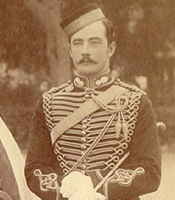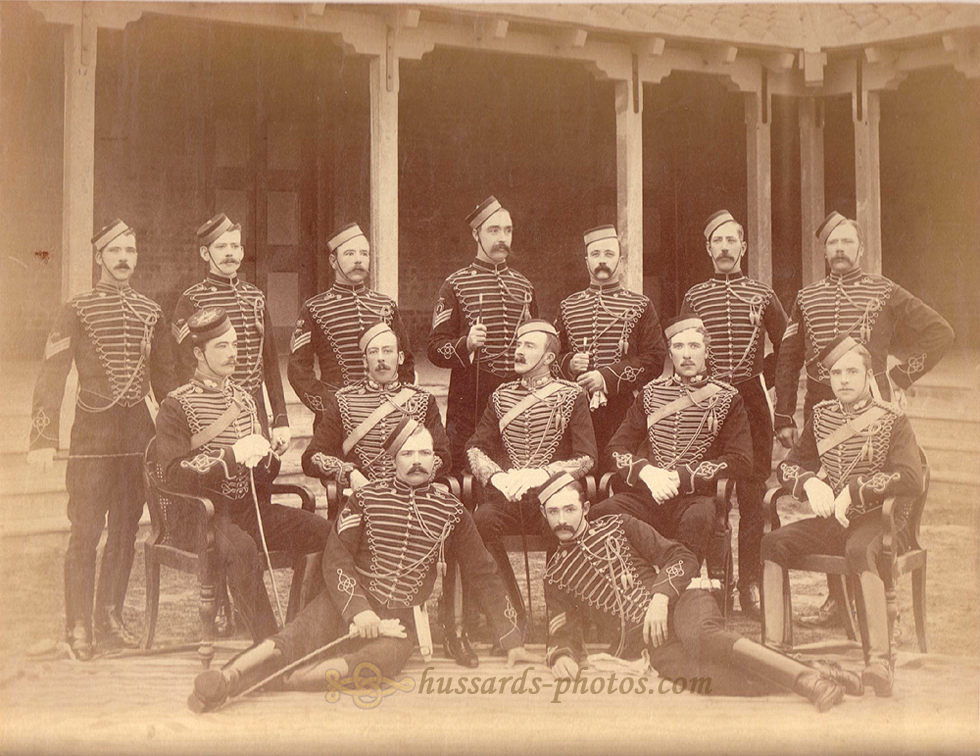 |
Lieutenant Webb Gillman His obituary was published in The Times
on Friday, April 21st, 1933 :
"SIR WEBB GILLMAN
G.O.C.-IN-C., EASTERN COMMAND
Of General Sir Webb Gillman, whose death is announced on
another page, it may be said that the Gunners have seldom produced one
who, both in barracks and on active service, has proved a more popular
and more successful Staff officer and commander. The second son of
Herbert Webb Gillman, of Clonteadmore, Coachford, Co. Cork, he was born
on October 26, 1870. His father was the senior descendant of John
Gillman, who went to Ireland
in 1599 as a lieutenant in the Army under the Earl of Essex, and traced
hi descent from Gifmin, the head of the 4th Royal Tribe of Wales, in
whose memory a monument exists at Glynllivon. |
From Dulwich
Gillman passed into Woolwich, where he shone in all athletic sports and
twice won the "Bugle" as "Victor Ludorum". He was
gazetted into the Royal Artillery in July, 1889, and became well known
as a good rider to hounds at home and after pigs in india, where he won
the Kadir Cup in 1897. He also played for the Royal Artillery at polo.
On the score of his horsemanship he was soon appointed to Horse
Artillery. In 1899,when serving with the "Eagle troop", or N
Battery, R.H.A., he was selected to go to the South African War with an
R.H.A. Ammunition Column. He thus took part in the early operations
culminating in the relief of Kimberley with French's Cavalry Division,
and was also present at the surrender of Cronje at Paardeberg, the
battle of Driefontein, and the subsequent capture of Bloemfontein. But,
having been promoted captain in the previous November, he was, much to
his chagrin, ordered to return to England, and was appointed adjutant,
R.H.A., at Aldershot. But the brigade, then under orders for the Cape,
never left home, and Gillman, despairing of seeing more service in South
Africa, volunteered in 1901 for special service in the Aro Ewpedition in
Southern Nigeria. There he served as staff officer to various columns,
and finally for his services received the D.S.O.
In 1902 he was again posted to the R.H.A. and went out to South Africa
in the following year, where he served till promoted major in 1905.
During these years he twice qualified for the Staff College, but failed
to pass in. However, in December, 1907, he was offered the post of
D.A.A.G., subsequently augmented to that of G.S.O. 2nd Grade, at Sierra
Leone. After spending one year in Africa he was appointed Assistant
Military Secretary, Eastern Command, but had hardly taken up his duties
before he received a special nomination for the Staff College, and
graduated, although he had entered 21/2 years over the usual age of 35.
On leaving Camberley he was sent to the Naval College at Portsmouth,and
in August, 1910, was appointed G.S.O. 2nd Grade, Southern Coast Defences,
at that place. In April, 1912, he was transferred to the War Office for
work under the Director of Military Operations and received a brevet
lieutenant-colonelcy in 1914.
At the outbreak of the Great War in 1914 he was allowed to leave the War
Office to assume command of the 114th Field Battery in the 1st Division.
With it he took part in the retreat from Mons and in the Battle of the
Marne, and came in for severe fighting during the crossing of the
Aisneand subsequent operations. In October, 1914, he was selected as
special liaison officer between Sir John French and Sir Douglas Haig,
and thus left his battery before the battle of Ypres had fully developed.
In January, 1915, he was selected as G.S.O. 1st grade with the 13th
Division of the new armies forming at home, and came home to assist in
its training. With it he went to Gallipoli in June, spending one month
in th trenches at Helles and the month of August at Anzac, where the
division suffered heavily in cooperating with the landing at Suvla. In
September, 1915, Gillman was appointed brigadier-general, R.A., of the
IXth Corps, but on the arrival of Sir Charles Monro as
Commander-in-Chief was transferred to his staff as B.G., G.S., and was
largely concerned with the arrangements for the evacuation of the
peninsula, being subsequently promoted to a brevet-colonelcy.
During the redistribution of troops in Egypt after the evacuation of
Gallipoli, Gillman was, in February 1916, sent to Mesopotamia as liaison
officer between the War Office and the Mesopotamia Force, and was
present during the final efforts to relieve Kut. On his retrn home in
May he was diverted from Egypt to Salonika to take up the appointment of
Major-General, General Staff, to Sir George Milne, appointed
Commander-in-Chief of the British Forces in June, 1916. He remained at
Salonika until August, 1917, when he was selected to command the 17h (Indian)
Division in Mesopotamia. But on Sir Stanley Maude's death he was
selected for the appointment of Chief of the General Staff to Sir
William Marshall, and remained in that post till the end of the War.
Gillman, who had been promoted substantive major-general in June, 1918,
returned home in March, 1919, where he was given command of the
demobilization centre at Catterick Camp. After a few months he was
appointed amemberof the Committee formed under Lord Esher to inquire
into the conditions and organization of the Army in India. His next
appointment was that of Commandant of the Royal Military Academy in
September, 1920,where he sayed until April, 1924, when he was
transferred to the ressucitated appointment of Inspector of Royal
Artillery at the War Office. During the tenure of his appointment he was
permitted to go as a guest of the French Government as a Military
Attaché on Marshal Pétain's staff in Morocco in the winter of 1925
during the operations against Abdel-Krim in the Riff country. In
NOvember, 1926, he was promoted lieutenant-general, and vacated
his appointment as Inspector, R.A. Early in the following year he was
sent to Singapore on a commission to report on the defences of the new
naval base ; and shortly after his return in October was appointed
Master-General of the Ordnance in succession to General Sir Noel Birch.
Both as Inspector R.A. and as M.G.O. Gillman was confronted with the
develoment of mechanization in the Army, and his appointment as M.G.O.
coincided with the reallocation of duties as between that officer and
the Quartermaster-General whereby the Directorate of Ordnance Services
came under the M.G.O. and the Director of Works under the Q.M.G., while
the M.G.O. was entrusted with the design and manufacture of guns, small
arms, ammunition, carriages, and ll tracked, semi-tracked, and wheeled
vehicles and with their maintenance, except those on R.A.S.C. charge. It
also was decided that he should be represented in the field, and a
D.M.G.O. was authorized for any future expeditionary force. The
financial stringency prevalent at that time prevented great results from
being achieved, and Gillman's reputation may have suffered somewhat
thereby. But it may be asserted that the years 1925 to 1930 marked an
era in the life of our Army which will be remembered as a turningpoint
in the use of mechanically propelled vehicles, both fighting and other.
Gillman succeeded to the appointment of G.O.C.-in-C., Eastern Command,
in March, 1931, and was promoted general in the following June.
Although Sir Webb Gillman never held a high command in the field, his
reputation as a true soldier stands asured. Wherever he went his common
sense and unassuming self-confidence impressed all those around him.
Without ever pretending to possess an outstanding intellect, hewould
surprise his staff by the clearness of his views. A strong believer
inthe principle of physical fitness, he practised what he preached, as
the cadets under his command at Woolwich could testify. With such a
character success came naturally,a nd he remained unspoiled, while he
continued to take the deepest personal interest in his regimental
associations to his last days.
Sir Webb Gillman was created C.M.G. in 1915, K.C.M.G. in 1919, and
K.C.B. in 1927. He was appointed a Colonel-Commandant of Royal Artillery
in 1930. In 1911 he married Elizabeth, daughter of the late Mr. Charles
Rube, and had one son, who recently passed out of the R.M. Academy, and
two daughters." |


